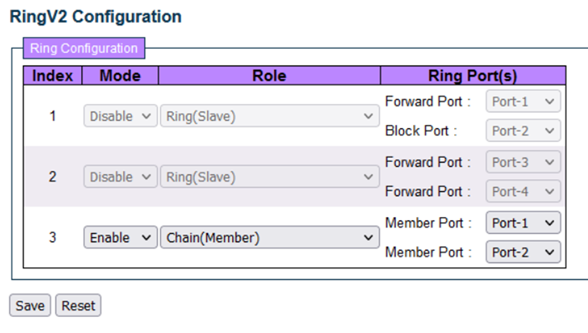RingV2
This page provides RingV2 related configuration.
See "Ring Version 2 Application Guide" in the ISW Series Managed Industrial Ethernet Switch Hardware Installation & User Guide for details about the available RingV2 configurations and how to configure them.

| Object | Description |
|---|---|
| Index | The group index. This parameter is used for easy
identifying the ring when user configure it.
|
| Mode | Enable Ring on the specific group. When Group 1 or 2 is enabled, all configuration of Group 3 will be reset to default. Group 3 all configuration options will be locked. To configure Group 3, both Group1 and 2 should be disabled first. When Group 3 is enabled, all configuration of Group1 and 2 will be reset to default. Group 1 and 2 all configuration options will be locked. |
| Role | Configure the Ring group on this switch as specific
role.
Note:
|
| Ring Port(s) | Selecting ring port(s). Each ring port must be unique, CANNOT be configured in different groups; 2 ring ports between ring/chain CANNOT be the same. # When role is ring/master, one ring port is forward port and another is block port. The block port is redundant port; it is blocking port in normal state. # When role is ring/slave, both ring ports are forward port. # When role is coupling/primary, only need one ring port named primary port. # When role is coupling/backup, only need one ring port named backup port. This backup port is redundant port; it is blocking port in normal state. # When role is dual-homing, one ring port is primary port and another is backup port. This backup port is redundant port; it is blocking port in normal state. # When role is chain/head, one ring port is member port and another is head port. Both ring ports are forwarding port in normal state. # When role is chain/tail, one ring port is member port and another is tail port. The tail port is redundant port; it is blocking port in normal state. # When role is chain/member, both ring ports are member port. Both ring ports are forwarding port in normal state. # When role is balancing-chain/central-block, one ring port is member port and another is block port. The block port is redundant port; it is blocking port in normal state. # When role is balancing-chain/terminal-1/2, one ring port is member port and another is terminal port. Both ring ports are forwarding port in normal state. # When role is balancing-chain/member, both ring ports are member port. Both ring ports are forwarding port in normal state. |
| Buttons | |
|---|---|
 |
Save changes. |
 |
Undo any changes and revert to previously saved values. |

